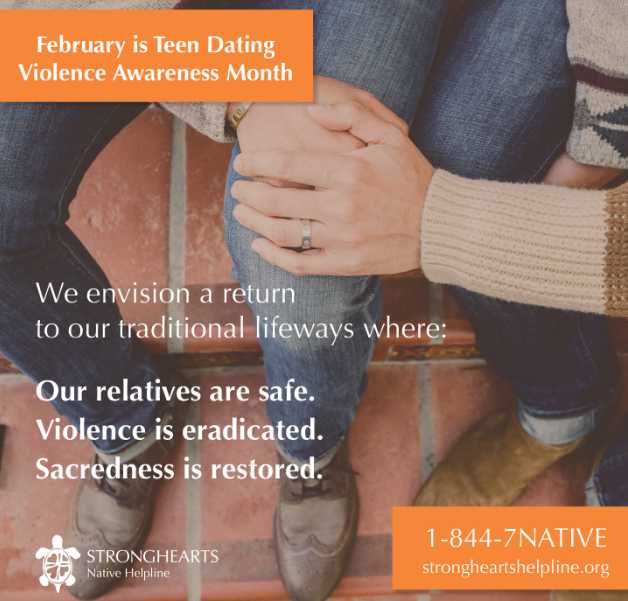
Domestic violence and dating violence happens when an intimate partner uses a repetitive pattern of abuse to maintain power and control over their partner. The abuse can physically harm, arouse fear, prevent a person from acting freely, or force them to behave in ways they do not want. Physical, emotional, financial, sexual, digital, cultural and spiritual abuse tactics are often used in combination by the abuser.
Violent behavior can appear at any time in a relationship, though possessive, controlling, and other alarming behavior often reveals itself as the relationship becomes more serious.
While it is impossible to predict what an abusive partner might do, in most abusive relationships the tactics of an abusive partner will escalate over time. This can make abuse seem normal and can happen in a way that a victim-survivor doesn’t notice as the abuse increases.
According to the National Institute of Justice, more than 4 in 5 Native Americans have experienced violence in their lifetime and more than 1 in 2 Native women (55.5 percent) and 1 in 3 Native men (43.2 percent) have experienced physical violence by intimate partners in their lifetime.
Strangulation
Strangulation is the act of using pressure around the neck or throat with enough force to affect the victim’s breathing. A common method used is manual strangulation where one uses their hands around the other person’s neck or throat. Some people may describe their strangulation experience using the word choking or choked. Choking, however is an internal obstruction in the upper airway which affects breathing.
Strangulation is one of the most serious forms of physical abuse.
- Strangulation is a significant predictor for future lethal violence.
- If your partner has strangled you in the past, your risk of being killed by them is 10 times higher.
- Strangulation is one of the most lethal forms of domestic violence: unconsciousness may occur within seconds, and death within minutes.
Additionally, homicide is a leading cause of death for Native women. (CDC)
The Training Institute on Strangulation Prevention lists many symptoms of strangulation, here are a few to be aware of:
- difficulty breathing
- drooling
- a sore throat
- difficulty swallowing
- neck pain
- hoarseness
- bruising on the neck or behind the ears
- discoloration on the tongue
- ringing in the ears
- bloodshot eyes
- dizziness
- memory loss
- nausea or vomiting
- incontinence
- a seizure
- a miscarriage
- changes in mood or personality, like agitation or aggression
- changes in sleep patterns
- changes in vision, such as blurriness or seeing double
- fainted or lost consciousness
If you’ve been strangled, we recommend that you consider seeing a doctor as soon as possible because it is possible to show no symptoms at first but experience potentially fatal symptoms as much as days later.[content id=”79272″]
Safety Planning
Working with an advocate to create an individualized, practical safety plan that includes ways to remain safe while in an abusive relationship may help.
If a violent encounter seems imminent and unavoidable, there are a few options to consider to keep you safe. These tips cannot guarantee your safety, but by using your experience and intuition, along with these tips, you may be safer. You are the best person to judge your safety.
- Remove necklaces, ties or scarves if you feel the violence is escalating as these may be used to strangle you.
- Say or do whatever you can to de-escalate the situation.
- Be aware of your surroundings. Think about what you could use to shield yourself when your partner becomes abusive.
After the Strangulation
After a violent encounter, it can be difficult to process what has happened, take time for yourself to recover and reconnect with yourself. Consider documenting the violence and abuse. Take pictures and write descriptions of the abuse in a journal or open an email account and email them to yourself. If there are any medical or police reports documenting the abuse, keep the records. Make sure your information is kept in a safe place. Keeping documentation will allow you to have an option to pursue legal action in the future.
Participating in self-care activities like exercise, eating healthy, counseling, journaling, knowing when and how to emotionally check out during times of duress could be helpful. Be gentle with yourself mentally and physically. Practice your spirituality by smudging, praying or sitting with your traditional medicines if this helps heal your spirit.
Help is Available
You have the right to live free from violence and abuse.
StrongHearts Native Helpline is a culturally-appropriate and anonymous helpline for Native Americans impacted by domestic, dating and sexual violence. Advocates offer peer support and advocacy, personal safety planning, crisis intervention and referrals to Native-centered domestic violence service providers. Visit strongheartshepline.org for chat advocacy or call or text 1-844-7NATIVE (762-8483) 24/7.
[content id=”79272″]








